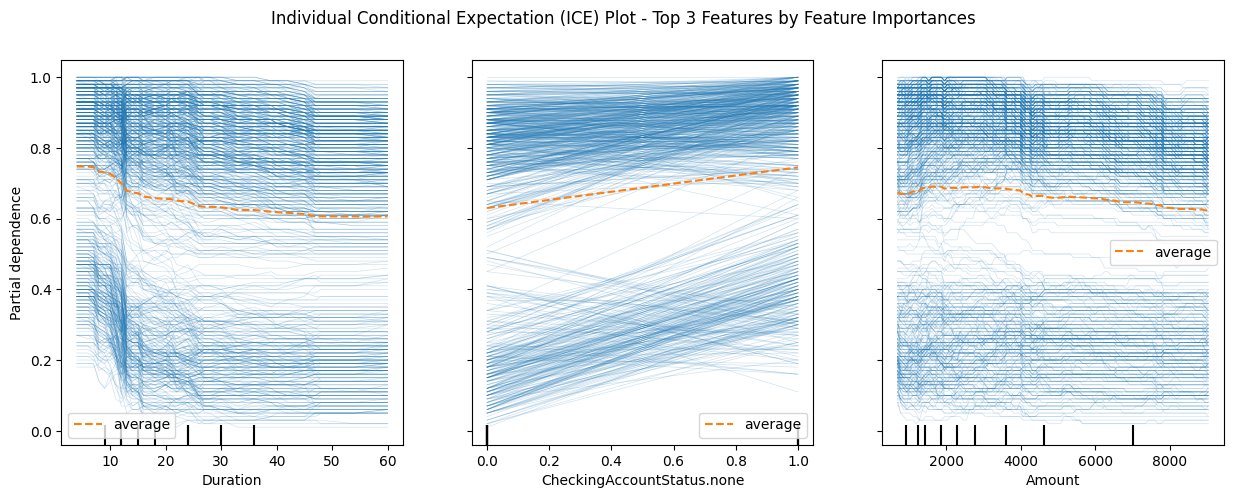Classifying the “German Credit” Dataset
This dataset has two classes (these would be considered labels in Machine Learning terms) to describe the worthiness of a personal loan: “Good” or “Bad”. There are predictors related to attributes, such as: checking account status, duration, credit history, purpose of the loan, amount of the loan, savings accounts or bonds, employment duration, installment rate in percentage of disposable income, personal information, other debtors/guarantors, residence duration, property, age, other installment plans, housing, number of existing credits, job information, number of people being liable to provide maintenance for, telephone, and foreign worker status.
Many of these predictors are discrete and have been expanded into several 0/1 indicator variables (a.k.a. they have been one-hot-encoded).
This dataset has been kindly provided by Professor Dr. Hans Hofmann of the University of Hamburg, and can also be found on the UCI Machine Learning Repository.
Building a decision tree
import pandas as pd
from sklearn.tree import DecisionTreeClassifier
from sklearn.metrics import classification_report
from sklearn.model_selection import train_test_split
from sklearn.model_selection import GridSearchCV
from sklearn.pipeline import Pipeline
from sklearn.preprocessing import StandardScaler
from sklearn.compose import ColumnTransformer
from sklearn.metrics import accuracy_score
from sklearn.metrics import balanced_accuracy_score
from sklearn.metrics import ConfusionMatrixDisplay
import seaborn as sns
import matplotlib.pyplot as plt
import warnings
warnings.filterwarnings('ignore')
df = pd.read_csv('./GermanCredit.csv.zip')
df.head()
Console output (1/1):
.dataframe tbody tr th {
vertical-align: top;
}
.dataframe thead th {
text-align: right;
}
df.info()
Console output (1/1):
<class 'pandas.core.frame.DataFrame'>
RangeIndex: 1000 entries, 0 to 999
Data columns (total 62 columns):
# Column Non-Null Count Dtype
--- ------ -------------- -----
0 Duration 1000 non-null int64
1 Amount 1000 non-null int64
2 InstallmentRatePercentage 1000 non-null int64
3 ResidenceDuration 1000 non-null int64
4 Age 1000 non-null int64
5 NumberExistingCredits 1000 non-null int64
6 NumberPeopleMaintenance 1000 non-null int64
7 Telephone 1000 non-null int64
8 ForeignWorker 1000 non-null int64
9 Class 1000 non-null object
10 CheckingAccountStatus.lt.0 1000 non-null int64
11 CheckingAccountStatus.0.to.200 1000 non-null int64
12 CheckingAccountStatus.gt.200 1000 non-null int64
13 CheckingAccountStatus.none 1000 non-null int64
14 CreditHistory.NoCredit.AllPaid 1000 non-null int64
15 CreditHistory.ThisBank.AllPaid 1000 non-null int64
16 CreditHistory.PaidDuly 1000 non-null int64
17 CreditHistory.Delay 1000 non-null int64
18 CreditHistory.Critical 1000 non-null int64
19 Purpose.NewCar 1000 non-null int64
20 Purpose.UsedCar 1000 non-null int64
21 Purpose.Furniture.Equipment 1000 non-null int64
22 Purpose.Radio.Television 1000 non-null int64
23 Purpose.DomesticAppliance 1000 non-null int64
24 Purpose.Repairs 1000 non-null int64
25 Purpose.Education 1000 non-null int64
26 Purpose.Vacation 1000 non-null int64
27 Purpose.Retraining 1000 non-null int64
28 Purpose.Business 1000 non-null int64
29 Purpose.Other 1000 non-null int64
30 SavingsAccountBonds.lt.100 1000 non-null int64
31 SavingsAccountBonds.100.to.500 1000 non-null int64
32 SavingsAccountBonds.500.to.1000 1000 non-null int64
33 SavingsAccountBonds.gt.1000 1000 non-null int64
34 SavingsAccountBonds.Unknown 1000 non-null int64
35 EmploymentDuration.lt.1 1000 non-null int64
36 EmploymentDuration.1.to.4 1000 non-null int64
37 EmploymentDuration.4.to.7 1000 non-null int64
38 EmploymentDuration.gt.7 1000 non-null int64
39 EmploymentDuration.Unemployed 1000 non-null int64
40 Personal.Male.Divorced.Seperated 1000 non-null int64
41 Personal.Female.NotSingle 1000 non-null int64
42 Personal.Male.Single 1000 non-null int64
43 Personal.Male.Married.Widowed 1000 non-null int64
44 Personal.Female.Single 1000 non-null int64
45 OtherDebtorsGuarantors.None 1000 non-null int64
46 OtherDebtorsGuarantors.CoApplicant 1000 non-null int64
47 OtherDebtorsGuarantors.Guarantor 1000 non-null int64
48 Property.RealEstate 1000 non-null int64
49 Property.Insurance 1000 non-null int64
50 Property.CarOther 1000 non-null int64
51 Property.Unknown 1000 non-null int64
52 OtherInstallmentPlans.Bank 1000 non-null int64
53 OtherInstallmentPlans.Stores 1000 non-null int64
54 OtherInstallmentPlans.None 1000 non-null int64
55 Housing.Rent 1000 non-null int64
56 Housing.Own 1000 non-null int64
57 Housing.ForFree 1000 non-null int64
58 Job.UnemployedUnskilled 1000 non-null int64
59 Job.UnskilledResident 1000 non-null int64
60 Job.SkilledEmployee 1000 non-null int64
61 Job.Management.SelfEmp.HighlyQualified 1000 non-null int64
dtypes: int64(61), object(1)
memory usage: 484.5+ KB
df.describe()
Console output (1/1):
.dataframe tbody tr th {
vertical-align: top;
}
.dataframe thead th {
text-align: right;
}
Mapping classes
Good -> 1
Bad -> 0
df['Class'] = df['Class'].map({"Good":1,"Bad":0})
df['Class'].value_counts().plot(kind='bar')
plt.grid(True)
plt.title("Number of times 'Good' (1) and 'Bad' (0) appeared in dataset")
plt.show()
Console output (1/1):
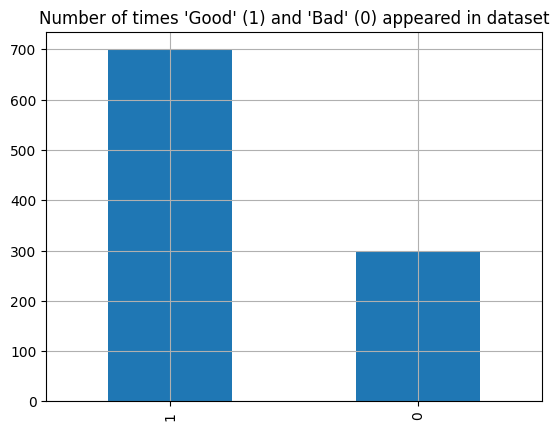
Observations
There is imbalance in the target variable, namely, there are over twice as many data points labelled as “Good” as there are points labelled as “Bad”.
Plotting the confusion matrix
def classify_grid_search_cv_tuning(model, parameters, X_train, X_test, y_train, y_test, n_folds = 5, scoring='accuracy'):
"""
This function tunes GridSearchCV model
Parameters:
----------
model
parameters
X_train
X_test
y_train
y_test
n_folds
scoring
Returns:
--------
best_model
best_score
"""
# Set up and fit model
tune_model = GridSearchCV(model, param_grid=parameters, cv=n_folds, scoring=scoring)
tune_model.fit(X_train, y_train)
best_model = tune_model.best_estimator_
best_score = tune_model.best_score_
y_pred = best_model.predict(X_test)
# Printing results
print("Best parameters:", tune_model.best_params_)
print("Cross-validated accuracy score on training data: {:0.4f}".format(tune_model.best_score_))
print()
print(classification_report(y_test, y_pred))
return best_model, best_score
# Use function
# Set dependend and independent variables
X = df.drop('Class', axis=1)
y = df['Class']
# Split data into training and testing data
X_train, X_test, y_train, y_test = train_test_split(X, y, train_size=0.8, random_state=1)
# Set pipeline
numeric_transformer = Pipeline(
steps=[("scaler", StandardScaler())]
)
preprocessor = ColumnTransformer(
transformers=[
("num", numeric_transformer, X.columns),
]
)
model_classifier = Pipeline(
steps=[("preprocessor", preprocessor), ("DecisionTree", DecisionTreeClassifier(min_samples_leaf=2, random_state=1))] #colsample by tree, n estimators, max depth
)
# Set initial model
model_classifier.fit(X_train, y_train)
y_pred = model_classifier.predict(X_test)
fig, ax = plt.subplots(figsize=(10, 5))
ConfusionMatrixDisplay.from_predictions(y_test, y_pred, ax=ax)
_ = ax.set_title(
f"Confusion Matrix for initial Decision Tree"
)
plt.show()
Console output (1/1):
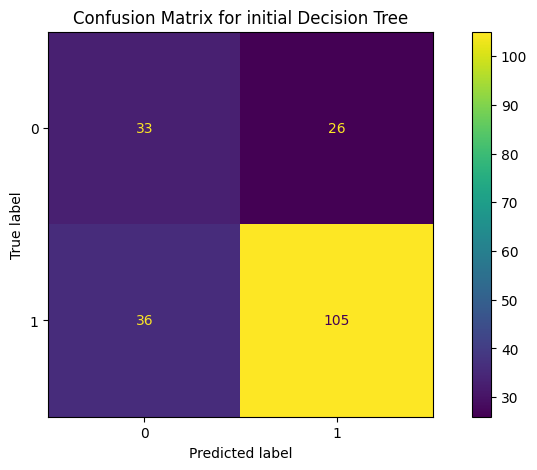
Improving model performance with hyper parameter tuning
from imblearn.pipeline import make_pipeline
from imblearn.over_sampling import SMOTE
# Set parameters
params = {'criterion': [ 'entropy'],
'splitter': ['random'],
'max_depth': range(5, 25),
'max_features': range(30,60)}
decision_tree_smote_pipeline = make_pipeline(
preprocessor,
SMOTE(random_state=42),
DecisionTreeClassifier(min_samples_leaf=2, random_state=1)
)
new_params = {'decisiontreeclassifier__' + key: params[key] for key in params}
best_dtc, dtc_score = classify_grid_search_cv_tuning(decision_tree_smote_pipeline, new_params, X_train, X_test, y_train, y_test, n_folds=5, scoring='f1_weighted')
Console output (1/1):
Best parameters: {'decisiontreeclassifier__criterion': 'entropy', 'decisiontreeclassifier__max_depth': 11, 'decisiontreeclassifier__max_features': 44, 'decisiontreeclassifier__splitter': 'random'}
Cross-validated accuracy score on training data: 0.7356
precision recall f1-score support
0 0.52 0.51 0.51 59
1 0.80 0.80 0.80 141
accuracy 0.71 200
macro avg 0.66 0.65 0.66 200
weighted avg 0.71 0.71 0.71 200
best_dtc.fit(X_train, y_train)
y_pred = best_dtc.predict(X_test)
score_train = best_dtc.score(X_train, y_train)
score_test = best_dtc.score(X_test, y_test)
# Print scores
print('score for training set', score_train, 'score for testing set', score_test)
balanced_accuracy = balanced_accuracy_score(y_test, y_pred)
print("Balanced accuracy score", balanced_accuracy)
# Print classification report
print(classification_report(y_test, y_pred))
# Plot confusion matrix
fig, ax = plt.subplots(figsize=(10, 5))
ConfusionMatrixDisplay.from_predictions(y_test, y_pred, ax=ax)
_ = ax.set_title(
f"Confusion Matrix for tuned Decision Tree"
)
plt.show()
Console output (1/2):
score for training set 0.87625 score for testing set 0.715
Balanced accuracy score 0.6549465079937493
precision recall f1-score support
0 0.52 0.51 0.51 59
1 0.80 0.80 0.80 141
accuracy 0.71 200
macro avg 0.66 0.65 0.66 200
weighted avg 0.71 0.71 0.71 200
Console output (2/2):

Random forest
from sklearn.ensemble import RandomForestClassifier
params = [{}] # Default parameters
random_forest_smote_pipeline = make_pipeline(
preprocessor,
SMOTE(random_state=42),
RandomForestClassifier(random_state=1)
)
rforest_best,rforest_score = classify_grid_search_cv_tuning(random_forest_smote_pipeline, params, X_train, X_test, y_train, y_test, n_folds=5, scoring='f1_weighted');
Console output (1/1):
Best parameters: {}
Cross-validated accuracy score on training data: 0.7526
precision recall f1-score support
0 0.68 0.46 0.55 59
1 0.80 0.91 0.85 141
accuracy 0.78 200
macro avg 0.74 0.68 0.70 200
weighted avg 0.76 0.78 0.76 200
rforest_best.fit(X_train, y_train)
y_pred = rforest_best.predict(X_test)
score_train = rforest_best.score(X_train, y_train)
score_test = rforest_best.score(X_test, y_test)
print('score for training set', score_train, 'score for testing set', score_test)
balanced_accuracy = balanced_accuracy_score(y_test, y_pred)
print("Balanced accuracy score", balanced_accuracy)
fig, ax = plt.subplots(figsize=(10, 5))
ConfusionMatrixDisplay.from_predictions(y_test, y_pred, ax=ax)
_ = ax.set_title(
f"Confusion Matrix for Random Forest Tree"
)
plt.show()
Console output (1/2):
score for training set 1.0 score for testing set 0.775
Balanced accuracy score 0.6827142685418921
Console output (2/2):

Computing feature importance
import numpy as np
importances = rforest_best._final_estimator.feature_importances_
std = np.std([tree.feature_importances_ for tree in rforest_best._final_estimator.estimators_], axis=0)
df_importances = pd.DataFrame([importances, std], index=['importances', 'std'], columns=list(X_train.columns))
df_importances = df_importances.transpose()
df_importances.sort_values('importances', ascending=False, inplace=True)
# Plot the feature importances of the forest
plt.figure(figsize=(10, 5))
plt.title("Feature importances")
plt.bar(df_importances.index, df_importances['importances'], color="r", yerr=df_importances['std'], align="center")
plt.xticks(rotation=90)
plt.xlim([-1, df_importances.shape[0]])
plt.show()
Console output (1/1):
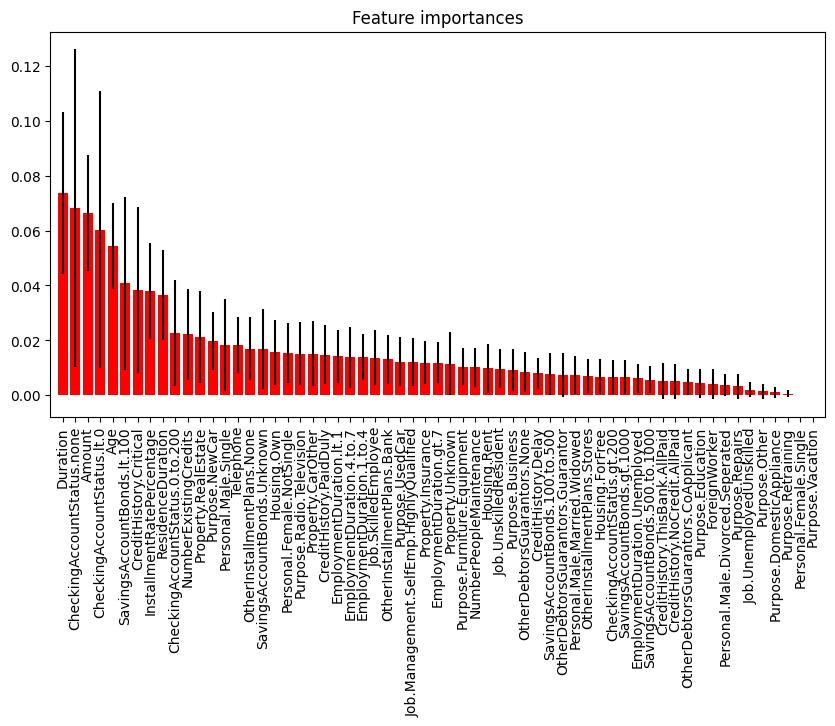
In this particular example, the top five most important features (in descending order) are:
- Duration
- CheckingAccountStatus.none
- Amount
- CheckingAccountStatus.lt.0
- Age
These features have importance scores ranging from 0.073 to 0.054, and their standard deviations suggest that the model is fairly certain about their importance rankings.
Computing Partial Dependence Plot
# compute partial dependence plot
from sklearn.inspection import PartialDependenceDisplay
PartialDependenceDisplay.from_estimator(rforest_best, X_train, ["Duration", "CheckingAccountStatus.none", "Amount"], kind='average')
cf = plt.gcf()
cf.suptitle("Partial Dependence Plot - Top 3 Features by Feature Importances");
cf.set_size_inches(15, 5)
Console output (1/1):
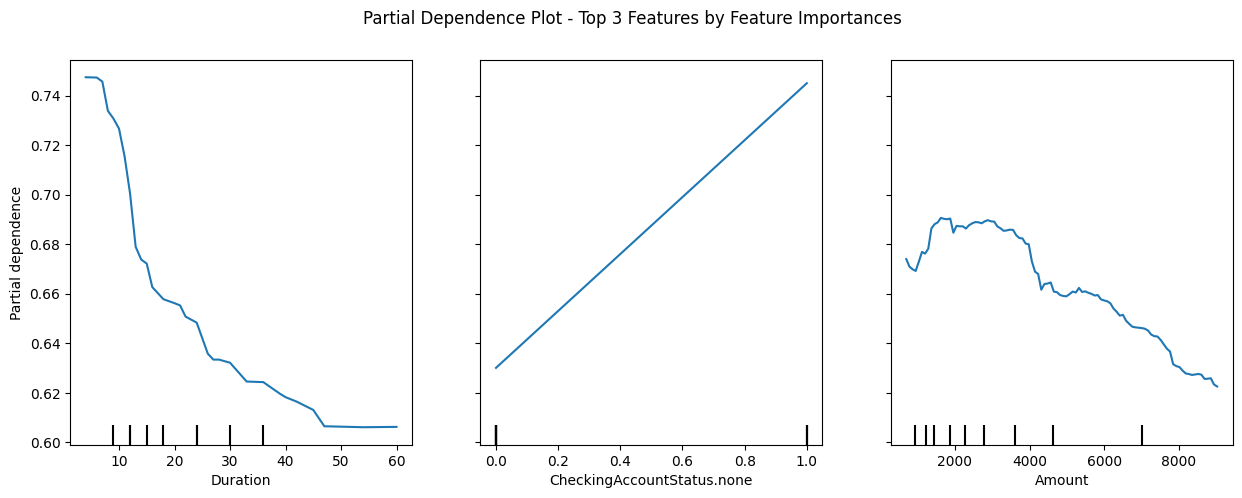
PartialDependenceDisplay.from_estimator(rforest_best, X_train, ["Duration", "CheckingAccountStatus.none", "Amount"], kind='both',
ice_lines_kw={"color": "tab:blue", "alpha": 0.2, "linewidth": 0.5},
pd_line_kw={"color": "tab:orange", "linestyle": "--"}
)
cf = plt.gcf()
cf.suptitle("Individual Conditional Expectation (ICE) Plot - Top 3 Features by Feature Importances");
cf.set_size_inches(15, 5)
Console output (1/1):
